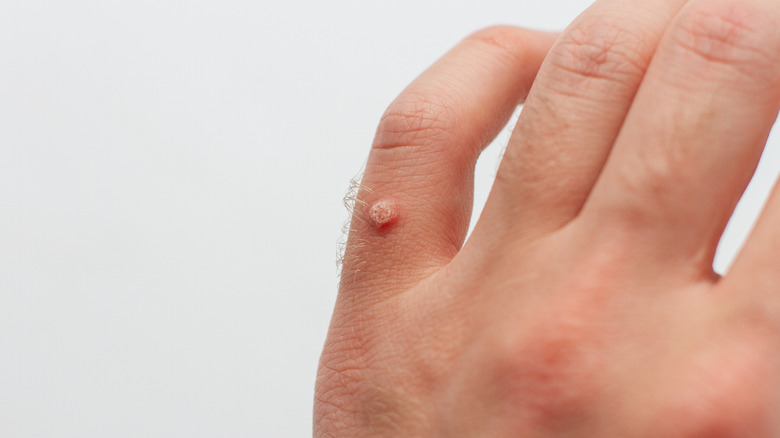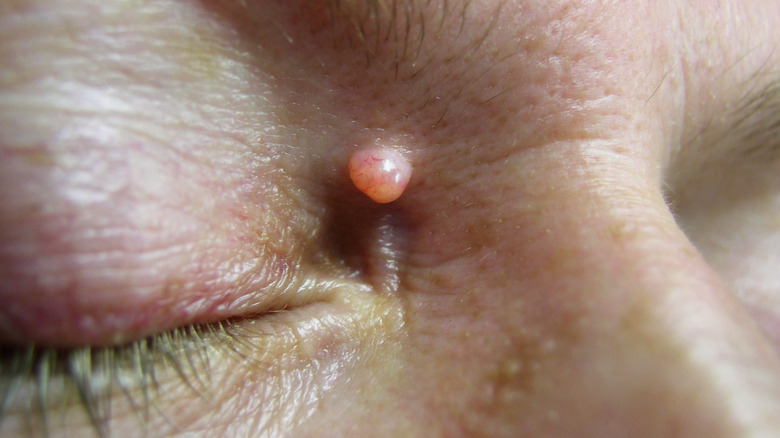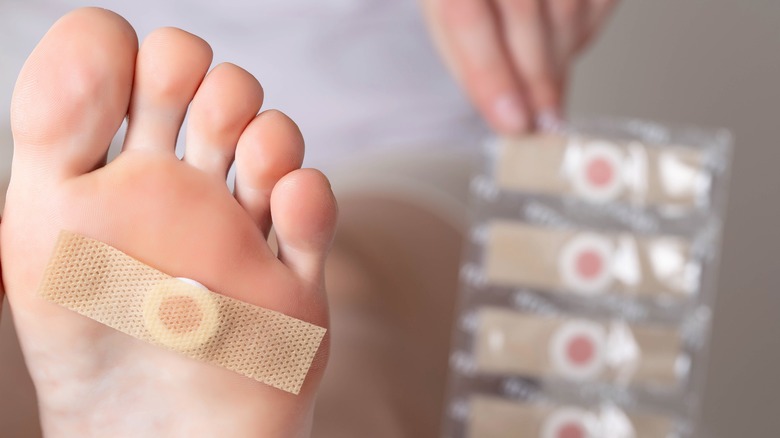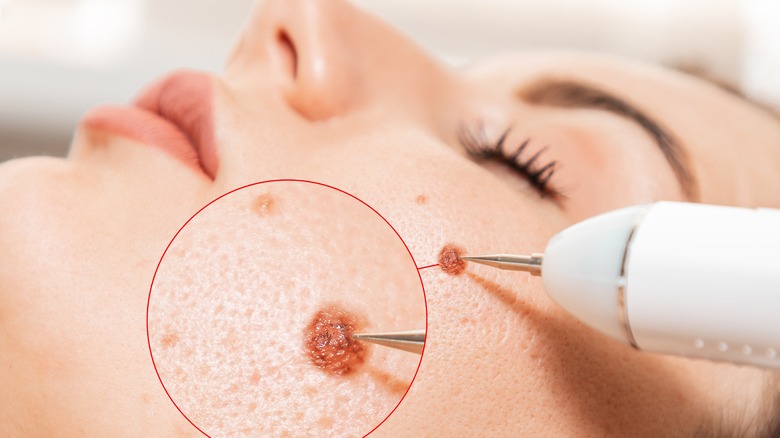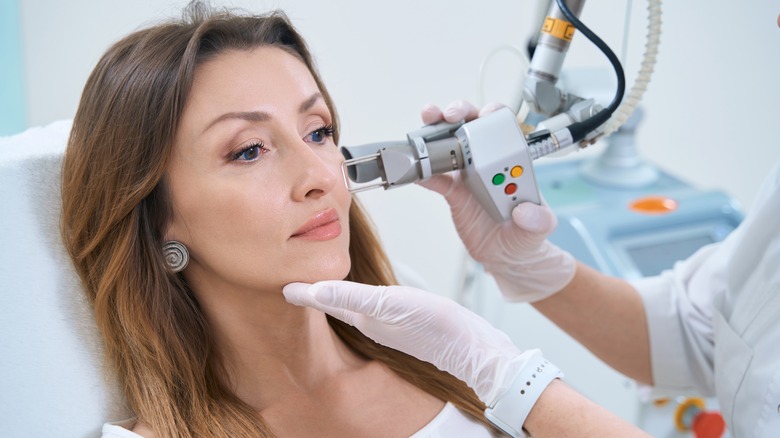How To Safely Remove A Wart
According to Medical News Today, a wart is a small growth that can appear anywhere on the human body. They're caused by the human papillomavirus, also known as HPV. There are over 100 types of HPV, which can be transmitted by touching someone with the condition. Furthermore, warts can grow anywhere on the body, explains Medical News Today. Anyone can get warts; however, some people are more prone to getting a wart virus than others, says the American Academy of Dermatology Association (AAD). This includes children and teens, of which one-third are estimated to have warts, according to Medical News Today. In contrast, only 3-5% of adults have warts. The AAD says that other risk factors for contracting HPV include biting nails and a weakened immune system. Warts can go away on their own, or you might need to give them that extra boost by treating them at home or in a doctor's clinic. Read on for more information on warts and how to safely remove them.
Types of warts
According to Nemours Children's Health, there are various types of warts, including flat warts, common warts, filiform warts, and plantar warts. Flat warts are small skin growths, often appearing in clusters and most commonly seen on the face. According to the source, they're smoother than the various other types of warts and usually have a flat top. Concerning their color, they can be light brown, pink, or yellow.
Common warts usually grow on toes, knees, and very commonly on the back of a finger. According to Healthline, common warts have a rounded top and can be grainy and rough in appearance. To identify a common wart, look out for a growth that might resemble a cauliflower, often appearing grayer than the surrounding skin. These growths can spread to other areas through direct contact.
Johns Hopkins Medicine describes filiform warts as long, narrow growths, not very large and usually appearing on the face or neck. Nemours Children's Health further describes these warts as having a finger-like shape, and as being flesh-colored, frequently showing up near the nose, mouth, or eyes.
As Healthline explains, plantar warts grow into your skin as opposed to growing outwards. According to the source, these warts are usually seen on the soles of the feet and are known to make walking more difficult due to their location.
How to safely remove a wart at home
According to Medical News Today, most warts clear up without treatment, but it might take a while before the wart disappears altogether. Two-thirds of warts will clear up fully within two years, says the source. To speed things up, you can choose to remove the wart at home by using salicylic acid. This treatment can be purchased over the counter in multiple forms, such as gels, creams, or medicated bandages. To benefit from using salicylic acid, Medical News Today advises applying it for several weeks up to several months.
As mentioned by the Mayo Clinic, you can also treat warts at home by using silver duct tape. The clinic recommends covering the wart with the tape for six days, then soaking the growth in water before removing all dead tissue with a disposable nail file or pumice stone. Leave the wart exposed to the air for around 12 hours before repeating the process until the wart is completely removed. The source notes that this remedy doesn't have any scientific studies to back it up, though, so it may not work as advertised.
How to prevent warts from spreading
To prevent warts from spreading, WebMD advises against touching them — try not to rub, scratch, or pick at them. The source also advises keeping skin in good condition — ensure it's properly moisturized with no cuts or sores. Biting nails is another habit to curb. According to WebMD, when you bite your nails, you expose the skin under the fingernails and cuticles to potential HPV infection. Healthline encourages washing your hands regularly, covering warts with a bandage, and keeping your feet and hands dry. These preventative methods become more important if you've been in contact with someone who has warts.
It's also important to protect yourself in external spaces such as pool areas, locker rooms, and public showers. The American Academy of Dermatology Association recommends wearing flip-flops since HPV thrives in warm, wet areas, while WebMD advises using fresh towels when at the gym or in other public spaces.
When to see a doctor
No doubt, warts can be embarrassing and unsightly, but as mentioned, they often go away on their own. If they persist or don't respond well to at-home treatments, seeing a doctor might be the next best point of call. According to Medical News Today, if the wart is painful, changes in its appearance, or bleeds readily, it might be a concern. Nemours Children's Health also advises calling a doctor if the wart oozes pus. In addition, warts that come back after a past removal or those that spread extremely easily to other parts of your body might require further examination, per Medical News Today.
According to the Cleveland Clinic, if the wart is itchy, appears to be infected or inflamed, breaks open often (thus increasing your rate of contracting an infection), appears on your rectum or genitals, or is particularly embarrassing to you, medical assistance is warranted. Before you speak to your doctor, it's best to note any particular symptoms that you'd like to discuss.
How doctors treat warts
According to the Mayo Clinic, laser treatments are one of the many ways doctors use to treat warts. During the treatment, a laser is aimed at the wart to burn the tiny blood vessels inside it, which kills all infected tissue, says the clinic. Surgery is another treatment option. In many cases, it's usually the last when a wart doesn't respond to any other treatment, says Healthline. During the surgery, your doctor might choose to burn the wart away or cut it with a surgical knife, but you'll require an anesthetic shot either way, which can be painful in itself. This method can also leave some scarring.
Your doctor might instead choose to use the freezing method. Freezing, also known as cryotherapy, involves using liquid nitrogen (via Cleveland Clinic). During this process, liquid nitrogen is used to freeze your wart, after which a blister develops. According to the source, the blister should fall off after some time, along with the wart; for maximum benefit, Cleveland Clinic suggests you undergo several treatments.

